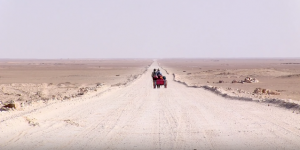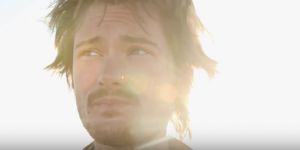Into the Empty Quarter 20 minute festival cut.
In this blog post, my comments and time stamps refer to the 20 minute festival cut.
Get Into the Empty Quarter feature length film here.
Into the Empty Quarter is an award winning 2013 documentary by filmmakers Alastair Humphreys and Leon McCarron.
Inspired by Wilfred Thesiger, who made a series of expeditions to the region nearly 60 years earlier, Humphreys and McCarron set off for the Empty Quarter desert on the Arabian Peninsula in November 2012. They traveled on foot, towing all supplies, food and water behind them on a homemade cart. Their route spanned 1,000 miles, starting in southern Oman and ending in Dubai.
A historic photo of Wilfred Thesiger and his camel, late 1940s. (1:49)
Humphreys and McCarron use present tense storytelling to bring us along on their expedition. By being both the creators and the stars of the film, they are utilizing a reflexive technique. The two use both scripted and unscripted editorializing and often turn the cameras onto themselves, vlog style. Despite the high stakes of the expedition, the characters come across as relatable and playful, which helps the viewer emotionally connect to the subjects during more trying portions of the trip.
The log-line, or the unanswered question that accompanies us throughout the film is, simply, “Will the expedition be successful?”
From the beginning, the filmmakers hint at this question by including comments about their qualms about the trip overall, design and mechanical issues with their cart, oppressive desert heat, and some waves of despair that come over them after pushing themselves physically and mentally in the middle of nowhere. In the end, they wrap up the unanswered question with a cinematic arrival in Dubai, and some thoughtful commentary about adventure inspiration and the idea of adventure heroes.
At 3:27, the film uses motion graphics laid over a map in order to portray their intended route.
The film’s map graphic, mid animation. The expedition had to skirt the Saudi Arabian border due to visa issues. (3:26)
Due to the central role the the journey or quest story arc tends to play in this genre, a map graphic, or at least the use of maps of some kind is essential. Not only does it spatially contextualize the expedition, but it gives the viewer a scope of just how grand their route was. In a film like Into the Empty Quarter, a map is a necessity, and Humphreys and McCarron take their maps to the next level with animation.
Because the two people on the expedition were also creating the film, they had to film themselves. This meant setting up a camera on a tripod, and walking past it, toward it, or away from it before returning to collect the equipment. Despite the grueling route, extreme heat and sun, and limited time and supplies, the Humphreys and McCarron do not skimp on collecting these wide, panoramic shots that depict them moving across the landscape. This film, and others like it, give new meaning to the expression “shoot and move”. They were also smart to include some ‘enter frame/ exit frame’ scenarios to aid in the editing process. Wide and ultra wide shots that feature the subject(s) are crucial elements of adventure filmmaking, because they contextualize the subjects and place them in the environment they’re passing through. As such, these establishing shots are a signature element of Humphrey’s and McCarron’s shooting aesthetic in this film. This story could not be told without these wide, locked down shots that feature the subjects. They show motion and progress across the landscape, which propels the subjects along and moves the story toward the resolution of the unanswered question. They display the beauty of the Empty Quarter’s desert landscape, which is a natural wonder that deserves to be showcased. The filmmakers stand out as a bright dot against the desolation and starkness of the desert, and these symmetrically balanced shots give us a sense of their isolation and remoteness. Again, they put the subjects in the context of their environment– two guys from the UK, pulling a weird cart in the middle of a vast, sandy plain with no buildings, water, or other people in sight. That alone is a compelling story, and it simply couldn’t be told without ultra wide shots. See below.
Humphreys and McCarron (and their cart) walking on an improved road near the start of their journey. (7:43)
In addition to using a compelling story arc, demonstrating clear proficiency with their cameras (Canon 5D and Canon XF100) and solid, tight editing, Humphreys and McCarron take the the time to stage and compose a number of visually interesting scenes that help carry the story along and make the film more visually diverse.
The silhouetting in the two shots below is used in a way that communicates the harshness of the Empty Quarter and, as such, adds to the story. As the sun goes down, Humphreys and McCarron are seen basking in the cool evening air, enjoying their nightly respite from the brutal daytime heat. The filmmakers decide to show this with these wide/ medium shots as opposed to simply saying it to the viewer with voiceover or first person narration. At 11:47, the pair dance around their campsite as the sun disappears behind the horizon. At 11:50, Humphreys can be seen swinging his arms, dancing again against the sunset. This communicates the joy of the relief brought with nightfall, and provides some nice character development. They show that despite being in a tough spot physically, these guys are friends and are enjoying their time together.
(11:47)
(11:50)
8:01 features nice closeup of McCarron as he talks about the state of expedition. In this scene, McCarron talks about how the ruggedness of the desert is dictating their route in ways that aren’t exactly as they had planned. He is clearly hot, tired and beaten down. Set up with his back to the sun, McCarron’s face is constantly shrouded with lens flare, and the background is washed out. This gives viewers the sense that the sun is unavoidable, inescapable, and a big consideration for McCarron and Humphreys.
(8:01)
This shot is from a sequence wherein McCarron and Humphreys are reconfiguring their cart before the start of their walk. After trying to pull it in the sand for the first time fully loaded, they realized they would have to make some slight changes to its design, and their trip is delayed while the cart sits at a fabrication shop. At 5:13, Humphreys is seen sitting, discouraged, on a couch in the street. The symmetry in the shot (the buildings in the background, the couch’s position relative to the buildings and the frame, and Alastair’s position on the couch) and the stark cleanliness of the street give us a lonesome, sterile feeling that adds to the feeling of helplessness conveyed by the accompanying voiceover. The shot lingers for 8 seconds, which aids in creating the feeling of being stuck. The following clips and voiceover, however, add that sometimes unexpected dilemmas on the road can lead to new developments, encounters and friendships that are great in their own way. This shot is a good bridge between those two ideas. Sometimes, when it feels like your fate is out of your hands, the best thing to do is just let go and go with the flow.
(5:13)
I have long been a fan of Alastair Humphreys, and I have learned a lot from this film and his other work. Into the Empty Quarter, along with other pieces of Humphrey’s and McCarron’s work, inspired a two person expedition I was a part of several years ago and has served as encouragement for my own personal travel and exploration.
One of my long term goals is to combine my expedition and backcountry experience with the filmmaking and storytelling skills learned in this program, and in so doing create a film like Into the Empty Quarter.
Websites:
Photos from Into the Empty Quarter expedition








Leave a Reply